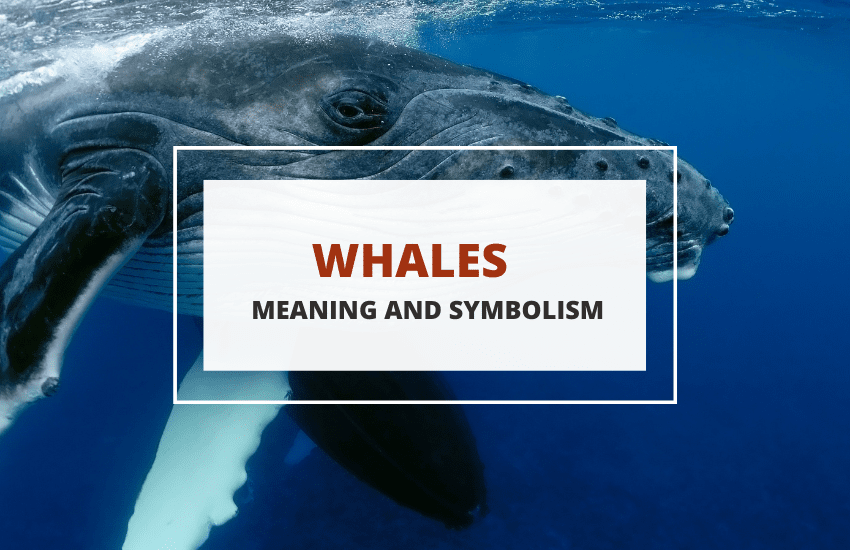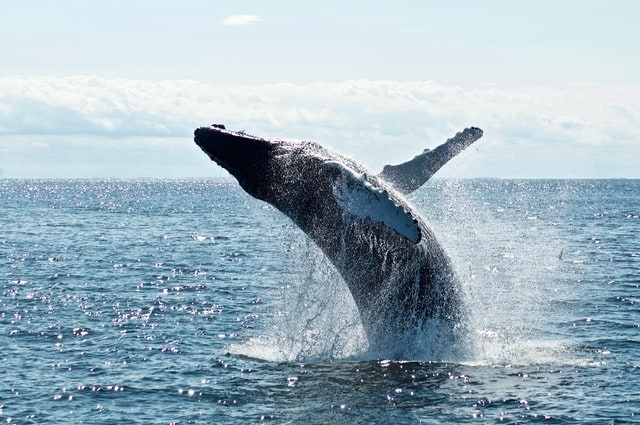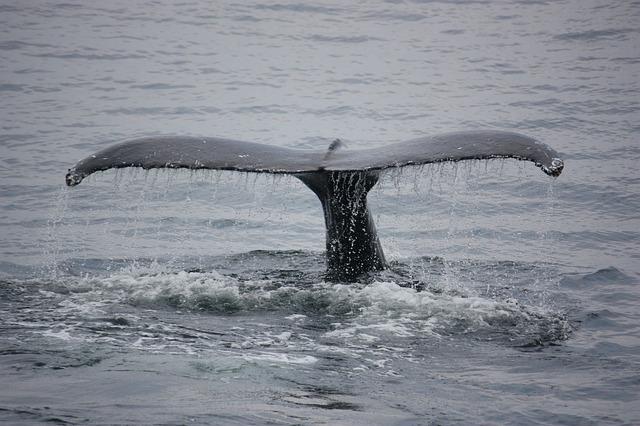
Symbolic Meaning of Whales
Known for their majestic size that can take your breath away. Because of how rarely we see them in real life, they’re unfamiliar, mysterious, and yet highly respected animals of the sea.
Whales symbolize a myriad of things, including intelligence, compassion, solitude, and free use of creativity. Let’s take a closer look at the symbolic meaning of whales.
What Do Whales Represent?
Grandeur and magnificence
There’s no denying it – whales are grand animals, awe-inspiring and simply stunning. Not only is this due to their large size, but also because of how sophisticated they appear. They’re intelligent and graceful, and yet they can also be compassionate beings.
Compassion
Among all the types of whales, the humpback whale is seen as one of the nicest animals on earth. Whales, in general, care a lot about the safety of their sea companions, and often tend to protect them from predators. They have also been seen protecting humans from danger. All this has associated them with kindness and compassion.
Intelligence
Whales have huge heads, making up to 40% of their body, which means they have large brains. They are also one of few animals, who capable of registering intricate emotions and feelings, and reacting to it.
Whales are also known to communicate with each other using echolocation and use music to attract their mates, which puts them on a higher pedestal than other animals. This behavior is enough to understand that their brain works on a much higher level, and that they are truly symbols of intelligence.
Communication
Whales possess skills that sometimes surpass a human too. They are perfectly capable of communicating underwater, at great lengths, using echolocation. It is a technique which uses sounds that reflect off of objects and give a sense of direction to the one using it. Whales, similar to bats, use it to navigate their paths in the deepest parts of the ocean, where there isn’t enough light to see. This ability helps whales even if they are blind.
Music
Whales are also known to understand the magic of music. According to marine biologists, whales use music to communicate with each other, and to attract their mates. Some stories also suggest that the first ever harp to be made, was carved out of a whale’s bones, which apparently possess the power of magic in them.
Psychic Abilities
Animals are mostly known to sense things like danger more often than humans, because they are more intuitive and have keener senses. They can easily understand the vibes in their surroundings, and often act according to what their intuition tells them.
Psychics also believe that the Cetaceans (Whales, Dolphins, Porpoises) have a strong innate psychic ability. The reason to come to this conclusion was because whales have been seen protecting smaller fishes, seals, and even humans from danger, and taking them away to safer places. They also know how to keep themselves out of peril, and when to ask for help from humans. They are extremely alert animals and are always aware of their surroundings.
Whale Spirit Animal

Having a whale as a spirit animal is like having someone very reassuring on your side. Whales are symbols of magnificence, gratitude, and compassion, and when a whale becomes your spirit animal, you are connected to it subconsciously and inherit all those qualities.
People with whales as their spirit animal are generally wise, understanding, and protective. You are heavily in tune with your psychic and intuitive abilities, and sometimes feel misunderstood. You also might have some problems communicating your thoughts, so it’s important to always be an open and honest communicator.
Whales in Mythology
Whales are not only respected or loved in modern times but have been worshipped since ancient times. In many areas and cultures over the world, whales have been given the highest amount of reverence and their magnificent and benevolent nature has been recognized since time immemorial. Below are accounts of different cultures, where whales are worshipped in distinct styles and traditions.
Oceana
For the Māori People of New Zealand and for the Australian Aborigines, the whale is seen as a water spirit that brings good fortune and prosperity.
Australian Aboriginal Story
In Australia, there is an important story about a whale called Gyian. The creator Baiyami, who lived on the Milky Way before the world was formed, used the stars to create the plants and animals on earth. Out of all his creations, his favorite was Gyian, the whale.
Baiyami promised Gyian that he would create a harmonious place for him and let him live in it. He brought with him Gyian and Bunder, the kangaroo, into the new world. He told Gyian that this place would now become his dreaming place.
New Zealand Story
New Zealand too, has a similar story of the Whale Rider. The Māori People believe the whale to be a descendent of the God of the oceans, Tangaroa.
A long time ago, a Chief named Uenuku lived on the island of Mangaia. He lived there with his 71 sons, out of whom, his youngest, Paikea, was his favorite. Paikea’s older brothers didn’t like his closeness with his father and schemed to drown him out of jealousy.
Fortunately, Paikea overheard them, and foiled their plans. When they were at sea, he purposely drowned their boat, causing all his brothers to die. Paikea too, fell into the sea, and was on the brink of drowning. Suddenly, a friendly whale named Tohorā came by, and rescued Paikea. It carried him all the way to New Zealand, and left him on the shore, where he settled down permanently. Paikea is now known as the Whale Rider.
Hawaii
Native Hawaiians see the whale as the God of the ocean, Kanaloa, in animal form. They not only view whales as guides and helpers, but also believe that whales are connected to the divine and spiritual part of the world. They treat the body of a whale as divine and sacred, and if ever a whale is washed ashore, they treat the ground with utmost respect, and have it guarded by chiefs called Alii and shamans called Kahuna.
Vietnam
Like Hawaiians, Vietnamese people too view the whale as a divine being and a protector. Vietnam has numerous temples where whales are worshipped, and they are named Cá Ông, which means God of Fish. In Vietnam, similar to the tradition in Hawaii, people will organize an elaborate funeral for a whale’s body, if found on the shore. The whale’s bones will then be respectfully placed in a temple. Because of the enormous respect Vietnamese people have for whales, it is obvious that they do not hunt whales.
Importance of Whales in Buddhism
In Buddhism, a story exists that talks about how whales were created to be so large. Once upon a time, a gigantic storm raged in the South China Sea. It was so powerful that it threatened to end the lives of the fishermen and animals who lived nearby. So, the great Lord Bodhisattva Avalokiteshvara took mercy on the people, and decided to help them.
The Bodhisattva removed a piece of clothing from his body, and tore it into multiple pieces which, by his power, turned into whales as soon as they touched the water. He sent those whales into the sea to protect the animals, but even they struggled badly against the high tides and strong currents. He then made them much larger, so that they could withstand the powerful waters, and take the people and animals away to safety.
Importance of Whales in The Bible
Whales make an appearance the Bible, most notably in the Book of Jonah. In this story, God orders the Prophet Jonah to go to the Assyrian City of Nineveh to warn them about their wicked ways, and that He would unfurl His wrath upon them if they didn’t alter their ways. But Jonah didn’t agree with God, and believed that humans didn’t change, and didn’t deserve to be rescued. As an act of rebellion, he changes course and sets out at sea.
During his trip, Jonah and his crew are met with a vicious storm that threatens to take all of their lives. Understanding this action as God’s wrath, Jonah climbs over the ship and the storm immediately subsides but is then swallowed by a whale.
Greece
The Greeks, being at sea most of the time, definitely came across whales. They believed that whales were an island called Aspidoceleon, meaning whale island. In Greek myths, sailors would stop on the Aspidoceleon, thinking it was an island when in reality, it was a vicious animal which would overturn their boats and eat them.
In another myth, Queen Cassiopeia of Ethiopia, was extremely proud of her beautiful daughter Andromeda, and invariably boasted about her beauty. She even went as far as calling her daughter more beautiful than Poseidon’s sea nymphs, the Nereids.
Poseidon, the God of the sea, was enraged at this claim, and sent his whale, Cetus, to attack Ethiopia. Cassiopeia decided to placate the monster by sacrificing her daughter Andromeda and chaining her to a rock at the edge of the ocean. Fortunately, Perseus, a Greek hero, came in to save Andromeda, and turned the sea monster Cetus to stone using Medusa’s head. Pained by the death of his favorite animal, Poseidon turned Cetus into a constellation.
What Are Whales?

Whales are majestic open-ocean creatures, and range in size from 2.6 meters and 135 kilograms dwarf sperm whale to the 29.9 meters and 190 metric tons blue whale, the largest animal to ever live on the planet.
Whales are primarily categorized into two types, Baleen and Toothed whales. Baleen is a fibrous plate present in the mouths of the whales, which helps them to filter out krill, crustaceans, and planktons from large amounts of water they consume, and throw out the excess of water back into the ocean.
On the other hand, toothed whales have teeth, which are used to feed upon large fish and squid. In addition to that, toothed whales also have a melon shaped mass of tissue on their heads. This helps them to communicate with one another or assess their surroundings using echolocation.
Whales generally can stay underwater for long periods of time, but since they have evolved from land-living mammals, eventually, they have to come up for air. This action is performed through blowholes located on top of their heads, through which they take in air and expel it out.
Whales have streamlined bodies and their two limbs are modified into flippers, which gives them the ability to travel to faraway places at a very high speed. Humpback whales, out of all their types, live without food for most of the year. They are believed to go without eating for at least five to seven months each year, during which they survive on the accumulated body fat inside them.
One interesting fact about the Narwhal whales is that their name comes from old Norse. It means Corpse Whale because their skin color reminded the Scandinavians of a drowned soldier. Whales also sometimes blow a plethora of bubbles around their prey, successfully entrapping them by confusing them, which makes it easier for the whales to catch their prey.
Wrapping Up
Whales hold a significant symbolism in many different ways and are truly interesting animals. Sadly, in today’s era, they are heavily endangered species, and are going through tough times. While a lot of people have worked hard to prevent whales from going extinct, they are still on the brink of extinction. We hope this information on whales helps you to understand their importance in life and help the whales to survive and make this world more beautiful.








